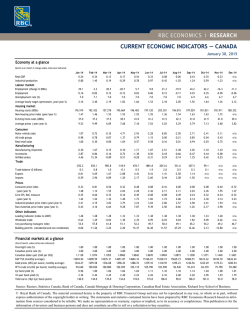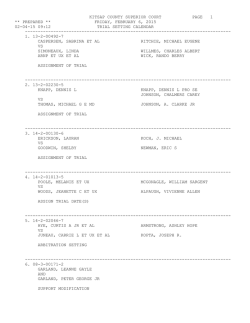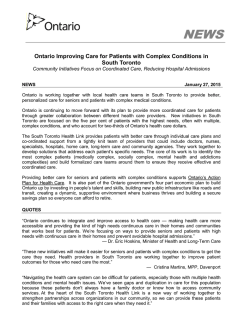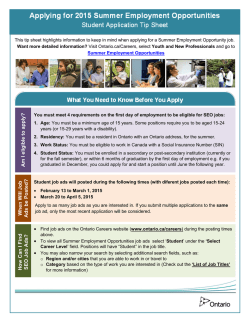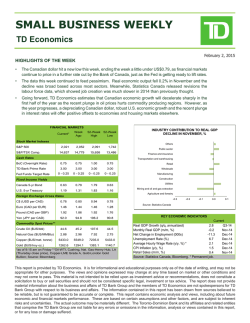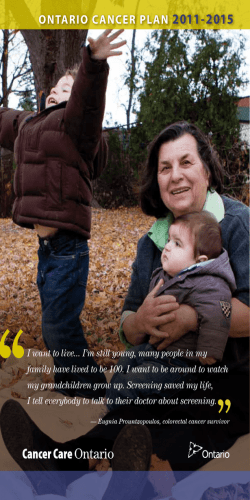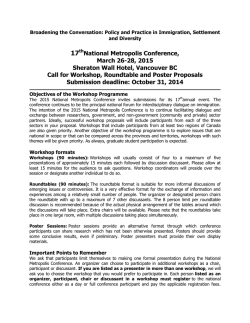
- Centre for Canadian Language Benchmark
Canada’s Directions in Settlement Language Training: Improving Newcomer Outcomes Anne Senior, CCLB Yves Saint-Germain, CIC Mourad Mardikian, MCIIT Agenda • • • • CCLB presentation CIC presentation MCIIIT presentation Question period Why are national standards important? By articulating standards for language proficiency, all stakeholders can now speak a common language and make informed decisions regarding settlement, training and employment opportunities. CLB 2000: A Guide to Implementation, page 9 CLB and NCLC The Canadian Language Benchmarks (CLB) and les niveaux de compétence linguistique canadiens are national standards for adult immigrants and prospective immigrants for living, studying and working in Canada. CLB are almost 20 years old! NCLC are a little younger. Why were they developed? The CLB /NCLC were developed by CIC in the mid-1990s to meet the needs of stakeholders working with adult immigran in Canada: To provide a common framework for second language teachers/administrators across Canada on which to develop classroom curricula and assessment tools. For use across community, work and school contexts. For use in provincial and national language training programs. CLB structure Progression is based on 3 factors: • Progressively more demanding communication tasks • Progressively more demanding contexts • Progressively higher expectations of effectiveness and quality of communicative competence Describe competency in four skill areas: 7 Communicative competence CLB describe language in terms of communicative competence: Communicative competence enables language users to express themselves in spoken and written texts, to interact with other speakers and writers, and to negotiate with others in a range of specified situations and social settings. Learning a language involves developing both communicative performance and communicative knowledge. Communicative competence takes into account socio-linguistic competence, pragmatic competence, and grammatical competence, etc. Essential to the notion of communicative competence are: the important role played by the context of discourse. the concept that language takes places in a setting and occurs for a purpose. that language speakers should be evaluated on their ability to use language to accomplish a set of tasks, under specifically defined performance and situational conditions. Role of the CCLB CCLB/CNCLC is the national, not-for-profit centre of expertise in support CLB and NCLC. It was founded in 1998 with support from federal and provincial governments. It worked with funders to revise the standards in 2012 to meet increasing demands for their usage in a variety of low-and high-stakes purposes. Increased rigor 2010-12, CLB and NCLC were revised to reflect their increasing use in a variety of different context including high stakes ones. Revision process included the development of a common theoretical framework based on a communicative competency model. The final stage of the revision/renewal process was a comprehensive validation process. Literacy document has now been revised: CLB ESL for ALL (Adult Literacy Learners) Theoretical framework behind CLB/NCLC Organizational Knowledge Pragmatic Knowledge LANGUAGE KNOWLEDGE Reflects models of language ability promoted by Bachman (1990), Bachman & Palmer (1996, 2010) and Celce-Murcia et al. (1995). For more information, refer to the Introduction section (pp. VI, VII) of the CLB/NCLC Common Theoretical Framework. Grammatical Knowledge Textual Knowledge Functional Knowledge Socio-linguistic Knowledge STRATEGIC COMPETENCE Maturation Tools and Resources • Tests for placement: CLBA, CLBPT, CLBLA, CLB-PT, ELTPA, WLA, BTC • Tests for high-stakes: Milestones, BTR • Tests for employment: CELBAN, ECLAB • Classroom resources: PBLA, Exit Tasks, SAM, Guide to Implementation, Curriculum guidelines • Resources for employment • Tutela.ca Language standards and employment CCLB Works with employers, sectors, counsellors Uses experts to correlate language standards with Essential Skills or to benchmark occupations Develops tools for training, assessing, and analyzing language levels for workplace/ preemployment training Result Higher stakes application of the CLB/ NCLC Increased knowledge of the language demands of benchmarked occupations Accountable tools that fairly assess language according to the needs of the occupation Support for employment and training decisions Any questions [email protected] www.language.ca www.tutela.ca Visit us at Booth 1928 TESOL 2015 International Convention & English Language Expo Canada’s Directions in Settlement Language Training: Improving Newcomer Outcomes March 27, 2015 Yves Saint-Germain Copyright [Citizenship and Immigration Canada, 2015]. This work is the intellectual property of the author. Permission is granted for this material to be shared for non-commercial, educational purposes, provided that this copyright statement appears on the reproduced materials and notice is given that the copying is by permission of the author. To disseminate otherwise or to republish requires written permission from the author. 17 Outline • • • • • • Department of Citizenship and Immigration Canada Settlement Program Settlement Language Programming Expected Outcomes of Language Programming Standardization in Language Development Formal Language Training – National Placement and Progression Guidelines – Curriculum Guidelines – Portfolio Based Language Assessment • Partners and Stakeholders 18 Department of Citizenship and Immigration • Selects foreign nationals and offers protection to refugees. • Develops Canada’s admissibility policy, which sets the conditions for entering and remaining in Canada. • In collaboration with its partners, conducts the screening of potential permanent and temporary residents to protect the health, safety and security of Canadians. • Helps immigrants and refugees settle and integrate into Canadian society and the economy, and by encouraging and facilitating Canadian citizenship. • Reaches out to all Canadians and fosters increased intercultural understanding and an integrated society with equal opportunity for all, regardless of race, ethnicity and religion. 19 CIC’s Settlement Program • Assists immigrants and refugees to overcome barriers specific to the newcomer experience (such as a lack of official language skills and limited knowledge of Canada) so that they can participate in social, cultural, civic and economic life in Canada. Needs Assessments and Referrals Formal reviews of client needs, leading to referrals to settlement and other community-based services Employment-Related Services Skills and supports to find employment commensurate with skills and education Language and Information and Orientation Skills Development Information to better understand life in Canada and make informed settlement decisions Supports to develop official language skills to live and work in Canada Community Connections Services to connect clients with the broader community, public institutions and community organizations Support Services Childcare, transportation assistance, translation and interpretation, crisis counselling and provisions for persons with a disability 20 Settlement Language Programming • Language Instruction for Newcomers to Canada (LINC) and Cours de langue pour les immigrants au Canada (CLIC) provide training, from literacy to advanced levels, to help newcomers develop the skills needed to function in Canadian society and contribute to the economy. • Programming covers aspects of living in Canada, job search skills, and cross-cultural communication to help newcomers find work and integrate into their communities. – Labour market language training offers job-specific programming (mainly at higher proficiency levels), coupled with mentoring and work placements to speed up the transition to employment. – Occupation-specific language training assists newcomers at intermediate language levels who have training or experience in a specific occupation or sector with the language and workplace cultural skills required to communicate effectively on the job. 21 Expected Outcomes of Language Programming • Efforts to standardize language training in Canada are guided by expected outcomes of the Settlement Program, which includes the following outcomes: Immediate: – Clients learn official language skills and other skills for adapting to Canadian society Intermediate: – Clients use Canada’s official languages to function and participate in Canadian society Ultimate: – Newcomer settlement and integration is supported in Canadian society – Newcomers contribute to the economic, social, and cultural development needs of Canada 22 Standardization in Language Development • Standardization and national consistency in the quality of programming supports strong newcomer language outcomes. • LINC and CLIC apply the Canadian Language Benchmarks (CLB) and Niveaux de competence linguistique canadiens (NCLC) as the national standard for planning curricula and assessing learner progress. – The CLB/NCLC include a number of descriptive statements called competencies. – These competencies are organized in 12 Benchmark levels that describe what a learner can do in the four skill areas (speaking, listening, reading and writing) at increasing levels of complexity. – The competencies provide a framework of reference for teaching and assessing adult ESL learners in Canada. 23 Formal Language Training • Formal language training offered as LINC and CLIC (whether inperson, online, or a blend of both) must be: – Task based instruction; – Preceded by a CLB or NCLC-based placement assessment; – Follow the National Language Placement and Progression Guidelines – Guided by LINC, CLIC, or provincial CLB- or NCLC-based curriculum guidelines for newcomers; – Led by a qualified teacher; and – Concluded with an evaluation of evidence collected throughout the term to determine progress on the CLB or NCLC scale (Portfolio-Based Language Assessment) 24 National Language Placement and Progression Guidelines • Introduced in 2014, the National Language Placement and Progression Guidelines established a national consensus on the interpretation of language proficiency levels based on the CLB and NCLC, that is: – Generally, the benchmarks assigned to a learner at the time of assessment mean that the learner has achieved, and demonstrated, the level of communicative ability associated with most or all (traditionally, 70 to 100%) of the descriptors for the benchmarks assigned in each of the four skills. – A learner who has been assigned a given benchmark is said to have completed that benchmark for the given language skill. • The guidelines are intended for language assessors, instructors, and coordinators in CIC-funded language training programs 25 Curriculum Guidelines • Intended to guide instructors in developing lesson plans tailored to the settlement needs and interests of learners in a manner that: – is consistent with the CLB and NCLC frameworks; – is task-based and learner-centred; and – supports the objective of the Settlement Program, which is to provide language instruction that facilitates social, cultural and economic integration into Canada. • Organized into twelve themes relevant for newcomer settlement – – – – – At Home in Our Community and the World Banking and Finance Canada Canadian Culture Canadian Law – Commercial Services and Business – – – – – – Community and Government Services Education Employment Family and Relationships Health and Safety Travel and Transportation 26 Portfolio Based Language Assessment • Portfolio Based Language Assessment (PBLA) is a standardized approach to teaching and assessment where teachers and students collaborate – on setting language learning goals, – on compiling evidence of acquired language skills in a variety of contexts over time, and – on analyzing and reflecting on progress. • Introduced April 2014 • National roll-out over three years 27 Partners and Stakeholders • Partnerships with provinces and territories – Federal-Provincial-Territorial Language Forum – Multilateral initiatives – Bilateral projects • Stakeholder engagement – National Settlement Council – Newcomer Language Advisory Body – National and regional conferences 28 Areas of focus going forward • Language training and skills development services that help newcomers attain the English and French proficiency they need to function and participate in all aspects of Canadian society, including: – Language placement assessments and referrals to training based on the national language framework (i.e. CLB and NCLC) – Language training and resources targeted at supporting newcomers to engage in basic social interactions and acquire Canadian citizenship – Language training and resources targeted at labour market entry and pursuing education – Newcomers with special needs (e.g. literacy, hearing or visual impairments) have access to learning opportunities and resources that can accommodate these needs – Newcomers destined to official language minority communities have access to the appropriate English and French language services and supports they need for full integration – Consideration for better integrating and promoting e-learning 29 Contact us Yves Saint-Germain Director, Language Policy, Francophone Minority Communities and Performance Measurement Citizenship and Immigration Canada E-mail: [email protected] For more information on CIC’s language programming, please visit: http://www.cic.gc.ca/english/newcomers/live/language.asp CIC’s video on Language Training for Canada is intended to raise newcomer awareness on the importance of official language skills for settlement in Canada Please visit us in the Exhibit Hall at Booth # 1739 30 Settlement Program Logic Model – As of April 1, 2013 Service Delivery Direct Services Program Components Needs Assessment & Referrals Information & Orientation Language Training Employment Related Services Indirect Services Community Connections Support Services offered across the Program to enable access to direct services: childcare, transportation, translation, interpretation, crisis counselling, and provisions for disabilities Target Groups Communities & Groups [Employers] Newcomers (eligible clients) Outputs Formal needs assessments (including follow-ups or reassessments) Information products Referrals to appropriate settlement services Individual & family consultations or counselling Settlement plans based on assessed needs and objectives Immediate Outcomes Intermediate Outcomes Ultimate Outcomes Departmental Strategic Outcome (SO3) Program Development & Management Orientation sessions & workshops (domestic and overseas) Basic skills development & training Language assessments Language training placements Skills development & training Work placements Formal language training classes Employment networking Informal language training sessions Employment counselling Client-Mentor matches Literacy classes Services connecting newcomers to public institutions and their communities Cross-cultural interactions and related activities Community activities Clients receive appropriate information and services to address settlement needs Clients attain awareness of community and other resources to deal with settlement issues Clients gain knowledge of life in Canada, including laws, rights, and responsibilities Clients learn official language skills and other skills for adapting to Canadian society Clients acquire knowledge, skills, and connections related to the Canadian work environment Clients have connections to communities and public institutions Clients make informed decisions about life in Canada, enjoy rights and act on their responsibilities in Canadian society Clients use official languages to function and participate in Canadian society Clients participate in local labour markets, broader communities and social networks Newcomers contribute to the economic, social and cultural development needs of Canada (PAA) Newcomer settlement and integration is supported in Canadian society Newcomers and citizens participate in fostering an integrated society (PAA) Service Providers/ Funding Recipients Capacity development and planning activities for nationally consistent service Initiatives for delivery professionals and partners Competency development outside of and training settlement activities sector Best practice Initiatives for activities & accessing pilots for foreignservice trained delivery workforce innovation Community partnerships for local planning & coordination Partners & stakeholders are engaged in settlement and implement strategies to address newcomers needs Provision of settlement services is consistent, innovative and coordinated Settlement and non-settlement services are responsive to the needs of newcomers and communities • Governance Policy research National & regional plans Program design, implementation strategies and related tools Program monitoring and performance measurement frameworks Functional guidance, support and training Program development, management and governance effectively support consistent and responsive program delivery 31 Government-Funded Language Programs The Ontario View Ontario Ministry of Citizenship, Immigration and International Trade March 2016 TESOL Conference Outline • Setting the Ontario Context • Program Applications of the Canadian Language Benchmarks • Ontario’s Language Training Vision 33 Immigration in Ontario: 2013 Trends and Facts Immigration in Ontario: Continuous Decline • As with elsewhere in Canada, Ontario’s actual share of PR landings continued to decline in 2013 – ON received 40.0% (103,402) of total PR landings to Canada (the highest in the country). • Ontario’s Immigration Strategy centres on attracting highly skilled workers and supporting diverse communities and growing a globally-connected economy. • Regions such as Peel and York saw increased PR landings compared with 2012: by 0.7%, and 1.3% respectively. 34 Immigration in Ontario: ProfilesDecline Immigration in Ontario: Continuous • In 2013, among Ontario’s 103,402 permanent residents: – 47,670 were Economic Immigrants – 39,121 were in the Family Class – 12,650 were Refugees – 3,961 were from the "Other" class • Among the 18,699 principal applicants arriving through the Economic Class, there were: The Top 10 countries of birth of Ontario’s Permanent Residents in 2013 were: Principal Applicants in Ontario Number Country of Birth Number Skilled workers 11,438 2,688 India 15,762 15,046 7,755 7,450 5,990 3,258 3,235 2,697 1,931 1,819 Live-in caregivers People's Republic of China Pakistan Canadian Experience Class 2,522 Philippines Iran Provincial/territorial nominees Investors Entrepreneurs Self-employed Total 1,385 580 53 33 18,699 United States of America Iraq Bangladesh Egypt Jamaica 35 ImmigrationininOntario: Ontario:Continuous Education Levels Immigration Decline • • • Most immigrants to Ontario (approximately 62%) in the past 3 years have completed at least secondary school. Over 45% of these immigrants have some post-secondary education. 2013 saw the highest number of Master’s degree holders (10,573) and Doctorate holders (1,614). 36 Distribution of CLBs by Language Skill (Cumulative Comparison – Toronto Region – previous 6 months) 20% 18% 16% 14% 12% 10% 8% 6% 4% 2% 0% 0 1 2 3 • 4 5 6 7 8 9 10 0 1 2 3 4 5 6 7 8 9 10 0 1 2 3 4 5 6 Assessment data reported from Toronto YMCA CLARS Centres 7 8 9 10 0 1 2 3 4 5 6 7 8 9 10 37 MCIIT’s Adult Non-Credit Language Training Program Immigration in Ontario: Continuous Decline • The Adult Non-Credit Language Training program is part of the Adult Continuing Education programs offered by Ontario District School Boards, and is designed to help immigrants improve their language skills in English or French. • The program serves 66,000 unique learners annually (total enrolment of about 130,000 per year), in over 350 locations, with full-time / part-time courses offered, ranging from 30 hours in length to 1,200 hours in length. • The course categories range from Literacy ESL /FSL courses, to Stage I and Stage II CLB level courses (CLB 1 to 8) offered as integrated courses or skill-based courses. There are limited courses covering Stage III (CLB 9) available in some regions. • A variety of customized courses are also offered, often based on identified local needs. As well, Specialized Language Training courses preparing learners FOR the workplace or for employees IN the workplace are also available in select regions. • Comprised of 2 main components: English as a Second Language (ESL) French as a Second Language (FSL) • FSL is a growing segment of language training program, with school boards delivering Adult Non-Credit FSL doubling from 3 to 7 from 2006/2007 to 2012/13. Today, there are over 3,000 individual FSL participants, representing a total enrolment of over 5,000. 38 Canadian Language Benchmarks - Program Applications STEP 1: What is my language proficiency level – in the Canadian Language Benchmarks? • • • • Get a language assessment from a local CLARS Centre; Receive my results in Listening / Speaking / Reading / Writing (with an explanation); Select from a range of courses identified based on assessment and program eligibility; Receive a referral to the desired course and attend class! Coordinated Language Assessment and Referral System (CLARS): • • • A joint initiative with the federal government, creating assessment centres across Ontario. Provides a single-point of access and a consistent approach to language assessment and referral for adult immigrants accessing both federal and provincial, English and French language training programs. Any existing learners who have a valid assessment (assessed <1 year ago or currently enrolled in language training) can be registered into courses as long as they meet the eligibility criteria established with the introduction of the CLARS protocols. 39 Canadian Language Benchmarks - Program Applications STEP 2: How are courses identified – in the Canadian Language Benchmarks? • • • All language training courses offered in Ontario (federally or provincially funded) are identified in a jointly used data management system called HARTs All courses have CLB skill levels assigned (min/max) in L/S/R/W Language training providers are responsible for updating their course being offered Learners select from the courses identified in HARTs HARTs course template: • 40 Canadian Language Benchmarks - Program Immigration in Ontario: Continuous Decline Applications STEP 3: New resource to develop new courses – in the Canadian Language Benchmarks • • • The provincial ESL/FSL program will be rolling out its new Ontario Curriculum Guidelines supported by an online portal – called Quartz – to provide instructors with a state- of-the-art tool to design and develop their courses, including their lesson plans All courses will have assigned CLB/NCLC skill levels (min/max) in L/S/R/W Quartz will be linked to existing resources available online to support course content 41 Canadian Language Benchmarks - Program Applications Immigration in Ontario: Continuous Decline STEP 4: Assessing learners in courses – in the Canadian Language Benchmarks • • • • There are a range of assessment tools available to instructors to conduct ongoing assessment of their learners All tools are aligned to the Canadian Language Benchmarks Nationally and in Ontario, a new approach to conducting assessments in class and recording the progress of learners is being rolled out – called PBLA All learners’ achieved results in their CLB are recorded in HARTs Portfolio Based Language Assessment (PBLA): • MCIIT is working in cooperation with the Centre for Canadian Language Benchmarks (CCLB) to coordinate the introduction of PBLA in ESL and FSL programs across the province in a phased manner (PBLA is also being introduced in LINC/CLIC programs in the same timeframe) • PBLA uses a portfolio of a learner’s language samples to contribute to on-going learner language assessment and final evaluation • It is designed to help learners demonstrate the language proficiency they have gained through their participation in language classes and support them in transitioning to either a higher level of language training, another training program, or the labour market • Beginning in Sept. 2015, all 37 school boards delivering the Adult Non-Credit Language Training 42 Program in Ontario will have started their PBLA training and implementation Ontario’s Vision for Adult Language Training I am an adult who wants to learn English or French as a Second Language. Language Training Classes Accessible Language Training • Adult Non-Credit Language Training • Bridge Training • LINC • ELT • OSLT Where am I going next? • Post-secondary • Accreditation • Work • Community Coordinated Language Assessment and Referral 43 THANK YOU! For additional comments or questions, please contact Mourad Mardikian through: [email protected] or 416.327.4331 44
© Copyright 2025

